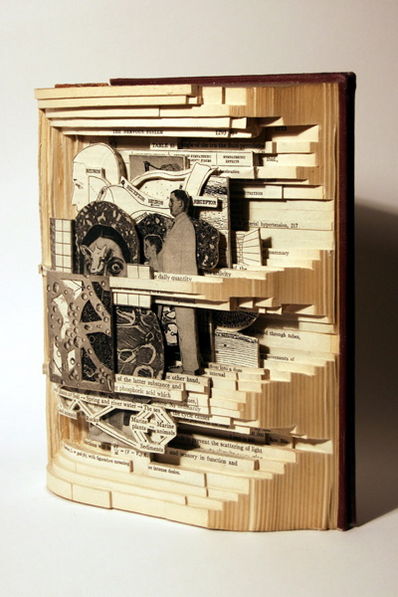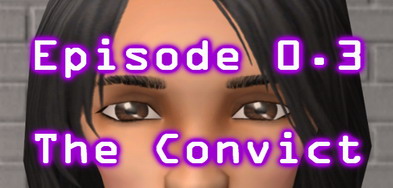
“The Physiological Basis of Medical Practice, 2006”, Altered book, 9 x 7-1/2 x 3-1/4 inches.
By Brian Dettmer at Haydee Rovirosa Gallery, New York.
(via Ron Silliman)
Category Archives: sculpture
sculpture as book

Last weekend, I found myself in the familiar position of racing to catch a long-running art show before it closed. This time it was the David Smith retrospective at the Guggengheim. (The show ends on May 14th.) The collection includes sculptural nods to Abstract Expressionism and Surrealism, as well as, foreshadowing Minimalism. Once an ironmonger, Smith employs found objects, he molds and welds into sculpture influenced as much by painting as the traditions of sculpture. While I generally prefer his larger scale pieces he produced late in his career, I was struck by a fascinating mid-career piece entitled, “The Letter” (1950).
The sculpture is a representation of a letter, that begins with a salutation in the upper right hand corner and closes with a signature. A range of theories abound to its meaning. Are the glyphs letters, words, human figures, or scenes? Is this a letter to his wife? One art historian suggests the text references a line from Wonderful Town and about leaving the state Ohio, where Smith spent part of this youth.
Or could it be a response to an author’s writing? The audio tour offered interpretations of a hint to the work of James Joyce that Smith gave in an interview. Listening to these following quotes from Joyce’s Finnegans Wake (0:40 – 1:16 of the audio fiie) while looking at the piece, I see and hear relevance to our work at the institute.
“ruled barriers, along which the traced words run, march, halt, walk, stumble”
and
“lines of litters slittering up and louds of ladders slettering down”
Whether it is our overarching discussion of the shift of print text to the computer screen or an overheard criticism of the latest sacrilegious film adaptation of a beloved book, the evolution of text beyond the printed page is clearly a dynamic process. We are aided when any creative mind can demonstrate these emerging relationships in a meaningful way.
In “the Letter,” Smith coyly reveals partial hints to the artist’s intentions, freeing the viewer to create her own insights. Smith is able to simultaneously display a multitude of reflections of meaning, with each suggestion containing a seemingly direct message to the viewer (as seen by the wide ranging interpretations.) Although the iconography could and does represent letters, words and bodies, I remain continuously enamored with the Joycian interpretation.
In that, Smith transforms a book into a sculpture. “The Letter” is bounded like a book, but within those boundaries, the gestures of abstracted forms (rather than letters), the use of open space, and the three dimensionality of the work surpasses that which it mimics. Further, the abstracted sculptural forms with their multiple readings comment upon the various meanings we take from words, which are also open to multiple readings. Therefore, Smith’s vision leaves us with a physical object that embodies not just the words, themes, and emotions of the book (that is the content), but also comments on the limitations of the book as an object (or vessel which holds the content).
Smith’s work, now 56 years old, seemingly poses to us two challenges. First, when we translate print text into the digital or create born-digital books, “the Letter” reminds us that in deciding to keep or reject aspects of both the content and the vessel of the traditional book, we must be conscious of the choices we make in that process. What are we willing to sacrifice in order to achieve something greater? Second, it asks us to look at these new forms with eyes unfettered by past conventions and to focus on, appreciate, and take advantage of the potentials of the new medium.
machinima: a call for papers and some thoughts on defining a form
Grand Text Auto reports a call for proposals for essays to be included in a reader on machinima. Most often, machinima is the repurposing of video gameplay that is recorded and then re-edited, with additional sound and voice over.
People have been creating machinima with 3D video games, such as Quake, since the late 1990s. Even before that, in the late 80s, my friends and I would record our Nintendo victories on VHS, more in the spirit of DIY skate videos. However, in the last few years, the machinima community has seen tremendous growth, which coincided with the penetration of video editing equipment in the home. What started as ironic short movies have started to grow into fairly elaborate projects.
Until the last few years, social research on games in general was limited and sporadic. In the 1970s and 1980s, the University of Pennsylvania was the rare institution that supported a community of scholars to investigate games and play. A vast proliferation of book and social research exists on gaming and especially video games, which we have discussed here.
Although I love machinima, I am surprised as to how quickly a reader is being produced. Machinima is still a rather fringe phenomena, albeit growing. My first reaction is that machinima is not exactly ready for an entire reader on the subject. I look forward to being surprised by the final selection of essays.
Part of this reaction comes from the notion that machinima is a rather limited form. In my mind, machinima is the repurposing of video game output. However, machinima.org emphasizes capturing live action/ real time digital animation as an essential part of the form, thereby removing the necessity of the video game. Most machinima is created within the virtual video gaming environment because that is where people are able to most readily control and capture 3D animation in real time. Live action or real time capture is different from traditional 3D animation tools (for instance Maya) where you program (and hence control) the motion of your object, background, and camera before you render (or record) the animation rather than during as in machinima.
Broadening of the definition of machinima, as with any form, plays a role on the sustainability of the form. For example, in looking at painting versus sculpture, painting seems to confine what is considered “painting” to pigment on a 2D surface. Where more expansive interpretations of the form get new labeling such as mixed media or multimedia. On the other hand, sculpture has expanded beyond traditional materials of wood, metal, and stone. Thus, the art of James Turrell, who works with landscape, light and interior space can be called sculpture. I do not imply that painting is by any means dead. The 2004 Whitney Biennal had a surprisingly rich display of painting and drawing, as well as photography. However, note the distinction that photography is not considered painting, although photography is 2D medium.
The word machinima comes from combining machine cineama or machine animation. This foundation does pose limits to how far beyond repurposing video game output machinima can go. It is not convincing to try to include the repurposing of traditional film and animation under the label of machinima. Clearly, repurposing material such as japanese movies or cartoons as in Woody Allen’s “What’s Up, Tigerlily?” and the Cartoon Network’s “Sealab 2021” is not machinima. Further more, I am hesitant to call the repurposing of a digital animation machinima. I am not familiar with any examples, but I would not be surprised if they exist.
With the release of The Movies, people can use the game’s 3D modeling engine to create wholly new movies. It is not readily clear to me, if The Movies allows for real time control of it’s characters. If it does, then “French Democracy” (the movie made by French teenagers about the Parisian riots in late 2005) should be considered machinima. However, if it does not, then I cannot differentiate the “French Democracy” from films made in Maya or Pixar in-house applications. Clearly, Pixar’s “Toy Story” is not machinima.
As digital forms emerge, the boundaries of our mental constructions guide our understanding and discourse surrounding these forms. I’m realizing that how we define these constructions control not only the relevance but also the sustainability of these forms. Machinima defined solely as repurposed video game output is limiting, and utlimately less interesting than the potential of capturing real time 3D modeling engines as a form of expression, whatever we end up calling it.
making visible the invisible: george legrady installation at seattle central library
A nice companion piece to the “database of intentions” is George Legrady‘s new installation, “Making Visible the Invisible,” at the Rem Koolhaas-designed Seattle Central Library. Six large LED display panels suspended above the “mixing chamber” on the library’s fifth floor display a series of visualizations depicting the circulation of library books and other media across time and classification area, providing “a real-time living picture of what the community is thinking.”
KeyWord Map Attack

Legrady described the project at the Transliteracies conference this past June in Santa Barbara. At that time, Bob blogged:
the pinpoint accuracy of computer-searches, leaves those of us lucky enough to have spent time in library stacks, nostalgic for the unexpected discovery of something we didn’t know we were looking for but which just happened, serendipitously, to be on a nearby shelf. George Legrady, artist and prof at UC Santa Barbara, just showed a project he is working on for the new public library in Seattle that gave the first glimpse of serendipity in online library searching which lets you see all the books that have recently been checked out on a particular subject. Beautiful and Exciting.
Vital Statistics

Floating Titles

Dot Matrix Rain

Other observations:
“New piece for Central Library pushes art to the technical edge” in Seattle Post Intelligencer
Information Aesthetics profile
